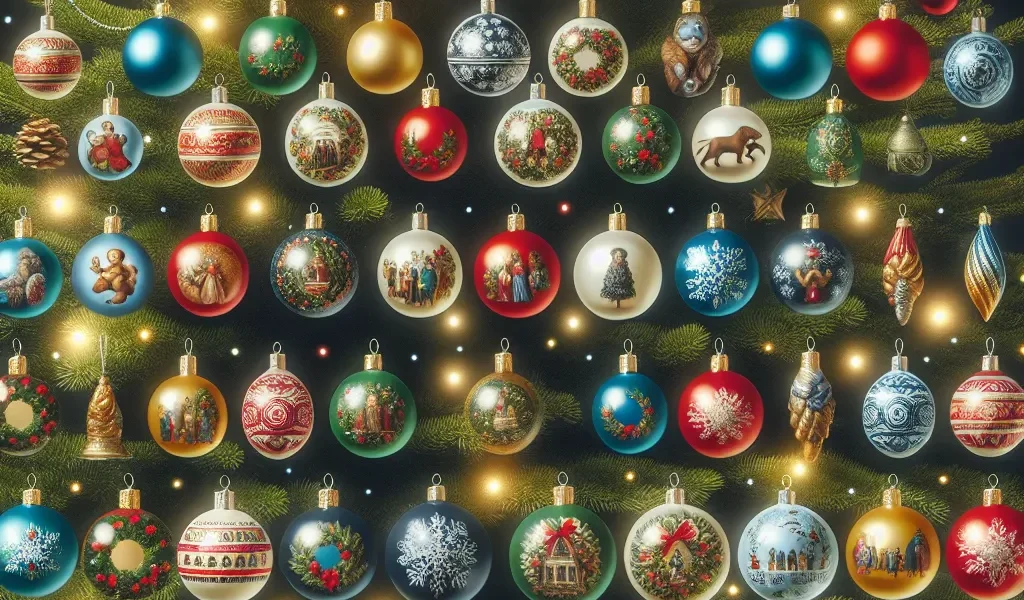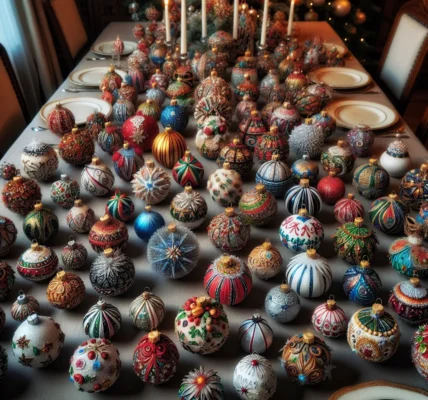The Origins of Christmas Baubles: A Historical Overview
Christmas baubles, also known as Christmas ornaments, have been an integral part of holiday decorations for centuries. The origins of Christmas baubles can be traced back to the 16th century in Germany, where they were initially crafted from glass. The tradition of decorating Christmas trees with baubles became popular in the 19th century, spreading across Europe and eventually to the United States and other parts of the world.
The early glass baubles were hand-blown and intricately painted, often depicting religious scenes or ornate designs. Over time, the production of Christmas baubles became more industrialized, allowing for mass production and a wider variety of designs and materials, including the use of metal, plastic, and other materials.
It is believed that the use of evergreen trees, such as the fir or pine, as a symbol of eternal life during the winter season, originated in Germany as well. The tradition of decorating these trees with ornaments, including baubles, evolved from pagan rituals to become a central part of the Christian celebration of Christmas.
As the tradition of decorating Christmas trees with baubles continued to spread, different cultures and regions developed their own unique styles and designs, incorporating local customs and craftsmanship into the ornaments. Today, Christmas baubles come in a myriad of shapes, sizes, and styles, reflecting the diversity of global holiday traditions.
From their humble beginnings as delicate glass decorations to the diverse array of ornaments available today, the history and evolution of Christmas baubles offer a fascinating glimpse into the interconnectedness of cultures and the enduring spirit of holiday celebrations.
The Evolution of Christmas Baubles: From Handcrafted to Mass Production
The tradition of decorating Christmas trees with baubles dates back to the 16th century in Germany, where the first baubles were handcrafted from glass, metal, or wood. These early baubles were intricate and often featured designs inspired by nature, religious symbols, or folklore. Craftsmen spent hours creating each piece, making them cherished heirlooms passed down through generations.
The industrial revolution in the 19th century brought about significant changes in the production of Christmas baubles. With the development of mass production techniques, the process of making baubles became more efficient, allowing for larger quantities to be produced at a lower cost. This made baubles more accessible to the general population, and they quickly became a popular and affordable decoration for Christmas trees.
In the 20th century, the introduction of new materials such as plastic and synthetic dyes further revolutionized the production of Christmas baubles. These materials allowed for a wider range of colors and designs, sparking a boom in the variety of baubles available. Today, Christmas baubles come in countless shapes, sizes, and styles, catering to a diverse range of tastes and preferences.
The evolution of Christmas baubles from handcrafted, intricate pieces to mass-produced, affordable decorations reflects the changing landscape of holiday traditions and the impact of industrialization on festive customs. Despite these changes, the joy and beauty that baubles bring to the holiday season remain as timeless as ever.
Symbolism and Tradition: The Meaning Behind Christmas Baubles
Christmas baubles, also known as ornaments, have been an essential part of the holiday decor for centuries. These decorative items, often made of glass, have a rich history filled with symbolism and tradition. The tradition of decorating Christmas trees with baubles dates back to the 16th century in Germany, where they were initially made of fruits and nuts. Over time, the materials evolved to include glass, metal, and other materials, and their significance also transformed.
The round shape of the baubles is said to symbolize eternity and the cycle of life, while the vibrant colors represent the beauty of the Christmas season. Additionally, the tradition of hanging baubles on the tree is thought to bring good luck and ward off evil spirits, a practice that has been passed down through generations.
Furthermore, the act of carefully unwrapping and hanging each bauble on the tree has become a cherished part of the holiday tradition for many families. It is a time for reflection, as each bauble holds memories of past Christmases and loved ones. In some cultures, specific colors or designs of baubles hold particular meanings, adding a layer of cultural significance to this beloved decoration.
As Christmas baubles have continued to evolve, they have become an iconic symbol of the holiday season, representing the warmth, joy, and togetherness associated with this festive time of year. Understanding the meaning behind Christmas baubles adds depth to the tradition of decorating, making it a truly special and meaningful experience for people all around the world.
Christmas Baubles in Modern Times: Trends and Innovations
In modern times, Christmas baubles have evolved beyond the traditional round shape and red and green colors. Today, we see a wide range of trends and innovations in the design and production of Christmas baubles, reflecting the ever-changing tastes and styles of consumers. One prominent trend is the use of non-traditional materials such as glass, wood, metal, and even plastic to create unique and diverse baubles. This shift towards unconventional materials has given rise to a more personalized and customizable approach to decorating Christmas trees.
Furthermore, the popularity of themed and novelty Christmas baubles has soared in recent years. From movie characters and pop culture icons to food items and travel destinations, the range of themes available for baubles is endless. This trend caters to individuals looking to add a touch of their personality or interests to their holiday décor. Additionally, the demand for sustainable and eco-friendly options has led to the emergence of biodegradable and recyclable Christmas baubles, appealing to environmentally conscious consumers.
Another notable innovation is the incorporation of technology in Christmas baubles. LED lights, sound modules, and motion sensors are being integrated into bauble designs, adding an interactive and dynamic element to traditional decorations. This integration of technology not only enhances the visual appeal of the baubles but also contributes to creating immersive and engaging holiday experiences.
In conclusion, the modern landscape of Christmas baubles is characterized by a diverse range of materials, themes, and technological advancements. As consumer preferences continue to evolve, it is expected that designers and manufacturers will further push the boundaries of innovation, resulting in even more exciting and unique Christmas bauble options in the future.

